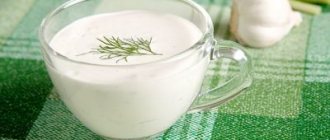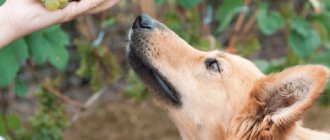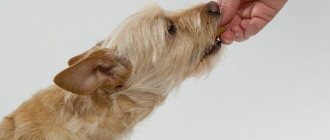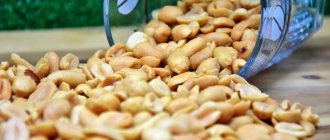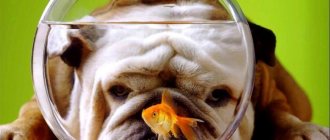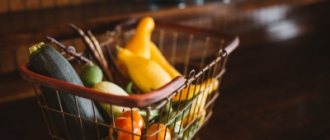A properly selected diet for a dog is the key to its health. Often, owners use only ready-made food, believing that it contains everything their pet needs.
In fact, for proper nutrition it is necessary to feed the animal vegetables, including beets. Below we will describe in detail how to give beets to a dog correctly, whether there are any benefits and contraindications.
Benefit
Beets contain a large amount of vitamins and microelements that are beneficial for the dog’s body. It is rich in fiber, which normalizes intestinal function. In addition, this vegetable has a beneficial effect on the functions of the cardiovascular system and liver.
Veterinarians also recommend including beets in a dog’s diet if it has been diagnosed with malignant tumors. Many breeders give their pets this vegetable to brighten their color. This is especially true for dogs of red breeds.
Harm and allergies
You can feed your pet beets either fresh or raw. But it should be borne in mind that it is a strong allergen, so it must be administered very carefully, in small portions. At the same time, it is important to monitor the reaction; if the animal shows signs of allergies (flatulence, itching, diarrhea), then the vegetable must be immediately excluded from the diet.
It should also be taken into account that beets change not only the color of excrement, but also the color of fur. Therefore, owners of light breed dogs participating in exhibitions will need to replace the beets with another vegetable.
Beet pulp
Pulp is included in most ready-made dog foods, including the most expensive ones. In the composition, this component may be listed as “beet pulp”. Pulp is obtained as a by-product when extracting sugar from beet tubers; it is a thread-like fiber without taste or odor.
There is an opinion that beet pulp in feed is a useless “empty” filler, but in fact this is a myth. This component is a valuable source of energy and plant fibers, which are necessary for the proper functioning of the gastrointestinal tract.
In addition, pulp is a prebiotic, which means it participates in the formation of probiotics. For puppies, beet pulp will be a valuable source of calcium, of which it contains a fairly high content (a consequence of the distillation of sugar). And, unlike fresh beets, the pulp does not cause such consequences as flatulence, diarrhea and changes in coat color.
How to give?
Beets do not lose their beneficial properties when cooked. In what form you give it to your pet, raw or boiled, will depend only on his preferences. Also, beets in different forms can cause different reactions in the body. For example, a raw vegetable is more likely to have a laxative effect than a boiled one.
Raw
Before feeding beets to your dog, they must be thoroughly washed and cut into small pieces or grated. Before serving, add a small piece of butter, as animal fats help vitamins to be better absorbed.
Also, finely grated vegetables can be mixed with porridge, other vegetables, meat, cottage cheese or sour cream.
Boiled
Boiled or steamed beets are better absorbed by the animal's body. In addition, it is easier to introduce it into the diet, since most often pets prefer boiled vegetables.
It is not recommended to give your dog fried or baked beets, as this may adversely affect the functioning of the pancreas. Boiled beets can be given separately or added to the main feed.
Leaves (tops)
Beet tops contain no less useful substances than the root vegetable itself. It can also be added to any food, after finely crumbling it.
It is not recommended to feed your pet store-bought tops, as they may contain large amounts of nitrates. For animal feed, it is better to purchase beets with tops from private traders or, if possible, grow them yourself.
Pulp (pulp, pulp)
Pulp (pulp, pulp) is a natural plant fiber obtained after processing beets and extracting sugar from them. It is added to almost all dry dog food, as it is a source of fiber necessary for normal digestion of the pet.
In addition, the pulp promotes the production of beneficial bacteria and fatty acids in the dog's intestines. Unlike root vegetables, it does not cause allergic reactions (flatulence, diarrhea, etc.) and does not change the color of the coat.
Beet fibers also have the following beneficial qualities:
- destroy harmful microorganisms in the intestines;
- pectin elements retain water, giving it a jelly-like form, which contributes to the normal formation of fecal matter;
- form an optimal lump of food mass, which allows the pet not to overeat.
Allowed varieties and methods of preparation
The root crop must be fresh, without traces of mold or rot! It is best if the beets are grown in your own garden and do not contain pesticides (read more about how to sow beet seeds and care for them here).
Dogs can be given small quantities of fodder and table red beets, but it is better to abstain from sugar beets.
To whom and what kind of beets is allowed to be given?
- Hamsters are allowed to give beets. Offer sugar with caution (large amounts of sugar can provoke diabetes), but it is better to refrain from food, because it contains practically nothing useful for the rodent.
- It is not advisable to give red beets to rabbits. It is best to give preference to feed and sugar.
- Budgerigars can be given sugar, fodder and table beets.
- Chickens can be safely given fodder and sugar beets, but not exceeding the permissible daily amount. But it’s better to be careful with red beets. The fact is that the color red has an irritating effect on animals. Once they get dirty in the juice, they can begin to react aggressively to each other or even fight.
- Guinea pigs can be offered any type of root vegetable and it will undoubtedly only benefit them.
- It is preferable to use table red beets to feed your cat.
In addition, to avoid negative consequences, the product must be properly prepared :
- cook over high heat;
- do not add salt or other spices to the water;
- do not keep it in water after cooking so that nitrates do not accumulate in the vegetable;
- Store beets in the refrigerator.
Even before our era, they knew about the healing properties of beets, although beetroot or beetroot, as this root vegetable is also called, is a completely common food product for many. Read our materials about whether this vegetable is allowed for a nursing mother during pregnancy, at what age it can be introduced into complementary foods for a baby, and whether its consumption can cause food allergies.
Pregnant and lactating
A pregnant dog needs proper balanced nutrition. If there were vegetables in her diet before pregnancy, then they should be left in the same amount. Veterinarians recommend replacing raw beets with boiled ones during pregnancy, since in their raw form they can cause flatulence.
If before feeding the puppies there were no beets in the dog’s diet, then you can start introducing them only after breastfeeding is complete. The new product may cause digestive problems such as diarrhea in puppies.
Vegetables that are not recommended for dogs
Broccoli is a source of fiber and will not harm your pet in moderation, but due to the isothiocyanate contained in broccoli, you should avoid this vegetable because isothiocyanate in large quantities is toxic to dogs. The amount of broccoli depends on the size of the pet and should not account for more than 5% of the diet. There is no point in feeding your dog broccoli in large quantities, which can lead to the death of the animal; this vegetable can easily be replaced with another, safer one.
Corn is an allergen and not all dogs can eat it. But if your dog doesn't have allergies, he can be given a few grains as a treat without oil or other additives. A lot of corn is harmful to digestion, and there is not much benefit from it, considering that it passes “through and through,” i.e., is not digested. You should not give corn cobs to chew, as they are not digestible and can cause intestinal obstruction, leading to the death of the animal.
Tomatoes can be included in an animal’s diet, but only as a treat. With frequent feeding in large quantities, stomach upset occurs, tremors, rapid heartbeat may occur, and some dogs experience allergies. Fresh ripe tomatoes are the safest, but green tomatoes and various tomato sauces should not be given.
Eggplants can be fed in small quantities, checking the body's reaction. Eggplant can cause an allergic reaction in some dogs. Contraindicated in dogs with kidney problems. The vegetable can be given occasionally, boiled or baked.
Potatoes are not recommended for dogs because they are not digestible and in large quantities clog the intestines. Raw potatoes are toxic, and if boiled potatoes are fed frequently, due to the high potassium content, they can lead to arthritis.
Garlic , however, like onions (including green onions, shallots), should not be given to dogs in any form. Of course, in very small quantities, garlic and onions will not harm health, but in large quantities, and the dog can eat them accidentally, for example, by stealing food containing these products from the table, they are toxic, leading at best to diarrhea and vomiting, and in the worst case to anemia, severe poisoning and death. Poisoning does not occur immediately, but several days after the dog has eaten garlic or onions.
Cabbage can be given in small quantities, raw, but it is better boiled, as it is better digested. In its raw form it causes gas formation (the dog farts often and unpleasantly), pain in the intestines, and bloating. Therefore, it is better to refrain from including cabbage in your dog’s diet. Of course, cabbage contains vitamins A and C, beta-carotene, but its benefits are not so great as to condemn the animal to intestinal discomfort. As for cauliflower and Brussels sprouts, these vegetables should also be given boiled, little by little (Brussels sprouts - 0.5-2 heads, depending on the size of the animal).
A boiled artichoke in small quantities is not dangerous, but the artichoke is poorly digested and often causes digestive upset, in particular diarrhea and vomiting.
to feed rutabaga ; in large quantities it can cause allergies and provoke hypothyroidism - a dysfunction of the thyroid gland.
legumes to a dog, because beans, peas, beans, and soy are not digested and often cause flatulence. It is acceptable to occasionally give fresh young peas, beans, green beans, boiled green soybeans, but there is no benefit from these products.
There is no need to feed your dog olives , especially olives and canned olives. There is no benefit from them, but indigestion can easily be caused. Olives can cause diarrhea or constipation and vomiting.
Different breeds
Due to its composition, beets are suitable for almost all breeds of dogs. Only Dalmatians cannot tolerate it. The only trouble that a vegetable can cause is a change in color in those with white fur. With excessive consumption of beets, the coat turns yellow or takes on a sandy tint in the following breeds:
- chihuahua;
- poodle;
- Maltese;
- Bichon Frize;
- Clumber Spaniel;
- silky windhound;
- white Spitz (Pomeranian or Japanese);
- Samoyed dog;
- West Highland White Terrier.
If it gets bad
To prevent beets from harming your pet, you must carefully monitor the feeding rate. An adult dog needs 20 grams of raw or boiled beets 1-2 times a week. Introduce complementary foods carefully, observing the reaction.
If the animal becomes ill after eating beets, then it is necessary to seek help from a veterinarian. The reasons may be:
- individual intolerance;
- allergy;
- violation of complementary feeding norms;
- pancreatitis and others.
Symptoms of poisoning:
- vomit;
- diarrhea;
- thirst;
- lethargic state;
- refusal to eat;
- in rare cases, spasms.
The first aid that must be provided to the animal is gastric lavage and an enema. After this, give any absorbent, for example, activated carbon.
What else should I feed?
Vegetables are essential in a dog's diet as they contain fiber, which is responsible for normal digestion. If for some reason your pet can’t eat beets, then it’s not a big deal. There are vegetables no less healthy than this root vegetable.
- Cabbage improves the functioning of the digestive system and has a positive effect on the quality of wool.
- Carrots contain large amounts of keratin.
- Cucumber has a positive effect on the functions of the cardiovascular and nervous systems.
- Celery reduces the risk of cancer, helps with arthritis and heart disease.
- Turnip has a diuretic and antiseptic effect.
- Pumpkin normalizes the functioning of the gastrointestinal tract.
Beet tops
Beet tops contain a lot of useful substances, even more than the root vegetable itself. Stored beets with tops are a controversial product due to the unknown nature of their origin and growing conditions. Tops treated with chemicals can be simply hazardous to health.
It’s another matter if you grow beets yourself, or know where you can buy beets grown in a private garden and completely safe. In this case, beet tops will be a very good addition to your pet’s diet.
The tops can be given boiled, they can also be cut and cooked mixed with other vegetables, or they can be dried and used in winter as a vitamin supplement with porridge.

